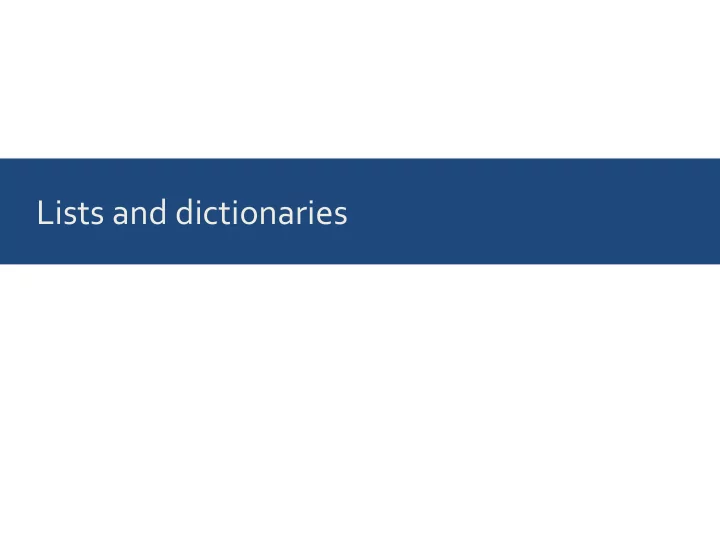

Lists and dictionaries
Lists: ordered collections of things In [1]: pets = ['fido', 'molly', 'tweety'] pets[0] # get 1st element of list Out[1]: 'fido' # result is a string In [2]: pets[1:3] # get 2nd and 3rd element Out[2]: ['molly', 'tweety'] # result is a list
Dictionaries: unordered collections of key-value pairs In [1]: pets = {'fido':'dog', 'molly':'cat'} pets['fido'] # return the value for key 'fido' Out[1]: 'dog' In [2]: 'molly' in pets # does dict have key 'molly’? Out[2]: True # yes In [3]: 'tweety' in pets # does dict have key 'tweety'? Out[3]: False # no
Conditional code execution
if / else statements if condition : statement else: alternative statement
if / else statements if condition : statement else: # optional, can be omitted alternative statement
if / else statements if condition : statement
Simple if / else example In [1]: if 2<3: print("yes") else: print("no") Out[1]: yes
Simple if / else example In [1]: if 3<2: print("yes") else: print("no") Out[1]: no
Indentation defines code blocks In [1]: if 3<2: # False print("1") # not run print("2") # not run print("3") # not run print("4") # run Out[1]: 4
Indentation defines code blocks In [1]: if 2<3: # True print("1") # run print("2") # run print("3") # run print("4") # run Out[1]: 1 2 3 4
Doing things multiple times (loops)
for loops for variable in list : statement
for -loop example In [1]: for name in ["John", "Sara", "Bill"]: print(name) Out[1]: John Sara Bill
Again, indentation defines code blocks In [1]: for name in ["John", "Sara", "Bill"]: print("----") # run for every name print(name) # run for every name print("----") # run once Out[1]: ---- John ---- Sara ---- Bill ----
We use for loops when we want to do something a number of times In [1]: for i in range(5): # range(5) creates the print("Hello!") # numbers from 0 to 4 Out[1]: Hello! Hello! Hello! Hello! Hello!
We use for loops when we want to do something a number of times In [1]: for i in range(5): # range(5) creates the print("Hello:", i) # numbers from 0 to 4 Out[1]: Hello: 0 Hello: 1 Hello: 2 Hello: 3 Hello: 4
One more example: Make a list of the numbers 1 through 5 In [1]: result = [] # start with empty list for i in range(1, 6): # count from 1 to 5 result.append(i) print(result) Out[1]: [1, 2, 3, 4, 5]
Combining loops and conditional execution
We often combine for loops and if statements Typical example: Loop over all elements in a list, and do an action if some condition is met.
Example: Find names starting with 'S' In [1]: for name in ["John", "Sara", "Bill"]: if name[0]=='S': print(name, "starts with S") else: print(name, "doesn't start with S") Out[1]: John doesn't start with S Sara starts with S Bill doesn't start with S
Example: Count names starting with 'S' In [1]: count = 0 # start with count of 0 for name in ["John", "Sara", "Bill"]: if name[0]=='S': count += 1 # increase count by 1 print(count) # print final result Out[1]: 1
Last example: Count how often letters occur in a string In [1]: sentence = "Time flies like an arrow." # first we count, using a dict counts = {} # empty dict for c in sentence: if c in counts: # have we seen this letter before? counts[c]+=1 # yes, increase count by 1 else: counts[c]=1 # no, set count to 1 # now that we have the counts, we print them for c in counts: # loop over all letters in the dict print(c, "appears", counts[c], "times.")
Last example: Count how often letters occur in a string Out[1]: i appears 3 times. k appears 1 times. o appears 1 times. r appears 2 times. l appears 2 times. appears 4 times. n appears 1 times. m appears 1 times. f appears 1 times. e appears 3 times. . appears 1 times. s appears 1 times. T appears 1 times. a appears 2 times. w appears 1 times.
Recommend
More recommend